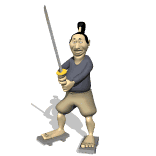|
Gambling |
|
Go (Ύ): This is a board game played by two people. The board is made up of a 19 ?~ 19 grid with 361 intersections. Black and white stones are used. Each player takes it in turn to place his stone on the board. The idea of the game is to capture the most territory. There are so many different possibilities with this game, it takes many years to become a reasonable player. NHK often have programs on the game. There are two professional organizations, the Nihon Kiin and the Kansai Kiin. |
|
Shogi (?«Šû): An oriental relation to chess. Each player has twenty pieces. The idea, as in chess, is to capture the king. This is quite an ancient game. As with Go, players are ranked by their skill. The Japan shogi Association has many professional members. Both Go and Shogi are thought to have been introduced to Japan from China. Shogi's origins trace back to India. |
|
Mahjong(–ƒ??): It was introduced to Japan in the early 1920's. It still remains a very popular, but complex game, which can be noisy at times. This is one way people in Japan relax and gamble informally (illegally). There are also many Mahjong parlors across Japan. |
|
Legalized Gambling Horse Races (‹£hn): Horse racing was introduced in its Western form in the late 19th century by the foreign community, living in Yokohama. It did not become popular, however, until after the second World War. In Japan horse racing is not "a sport of kings" but of the common man. |
|
Bicycle Racing(‹£—Ö): It was started in 1948 to stimulate the Japanese economy and help the bicycle industry. It was one of the top gambling sports at one stage. Today it still retains some popularity. |
|
Motorboat Racing(‹£fø): This is a recent addition in Japan. I don't think it is quite as popular as bicycle racing. Women also compete in this sport for big prize money. |
|
Lotteries: National lottery tickets cost 300 Yen each and the top prize for a single ticket is 60.000.000 Yen. The draw is held twice a year winter and summer. There are also other lottery draws, with smaller prize money. |
|
Pachinko: Perhaps the most popular form of gambling. Pachinko parlors are liberally spread all over Japan. The parlors are amazingly noisy places, often filled with cigarette smoke.
A spring mechanism is used to fire a steel ball up a vertical board with various holes in it. There are nails and other devices to deflect the ball. It is not an easy game to win at. The
parlors employ professionals to adjust the nails in the boards, to make it
more difficult to win. However, there are people who devote themselves to
the game and some even make a very comfortable living just from winning at
pachinko. This is a popular game for many types of people. The flashing
lights and the different themes used for the pachinko machines, make it
almost like a narcotic. I have tried a few times. Each time I spent 1.000
Yen and lost it in about 5 minutes. Many housewives have taken up playing
pachinko, leaving their small children in their cars or unattended at
home. This has led quite often, to tragic results, especially in the
summer, when the thoughtless parents leave children in cars with windows
closed, and so on. Some pachinko parlors, recently have decided to open
playrooms for |
|
Martial
art
The Meaning: @ Martial
art takes the holistic approach. @ |
|
Judo
|
|
Kendo
|
|
Kyudo or Kyujutsu @ Archery is another ancient Japanese sport. Kyudo has not changed very much since those times. It is still quite a popular sport, many young women enjoy it. |
|
Karate @ Karate
originated in the Tang dynasty (618 - 907) of China and was developed in
Okinawa, where it became known as Karate (Tang hand) . |
|
Aikido(?ö‹Cg¹)
|
